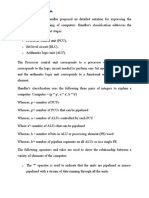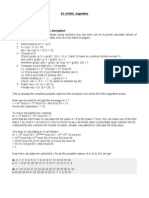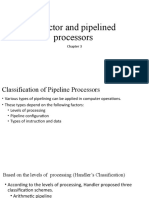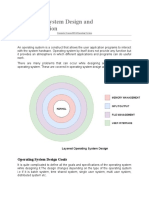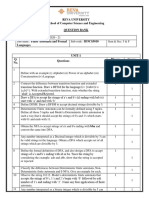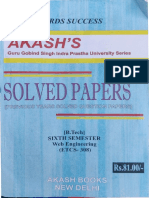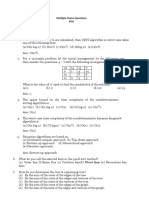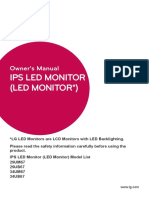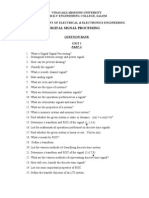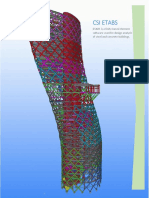0 ratings0% found this document useful (0 votes)
OS Services
OS Services
Uploaded by
Anil KumarThe operating system provides services to both users and programs. It provides an environment for programs to execute, handles input/output operations since programs cannot perform I/O directly, and enables file system manipulation like reading, writing, creating and deleting files. The operating system also facilitates program execution, communications between processes, error detection, and a user interface.
Copyright:
© All Rights Reserved
Available Formats
Download as PDF, TXT or read online from Scribd
Download as pdf or txt
OS Services
OS Services
Uploaded by
Anil Kumar0 ratings0% found this document useful (0 votes)
The operating system provides services to both users and programs. It provides an environment for programs to execute, handles input/output operations since programs cannot perform I/O directly, and enables file system manipulation like reading, writing, creating and deleting files. The operating system also facilitates program execution, communications between processes, error detection, and a user interface.
Original Description:
operating system services
Copyright
© © All Rights Reserved
Available Formats
PDF, TXT or read online from Scribd
Share this document
Did you find this document useful?
Is this content inappropriate?
The operating system provides services to both users and programs. It provides an environment for programs to execute, handles input/output operations since programs cannot perform I/O directly, and enables file system manipulation like reading, writing, creating and deleting files. The operating system also facilitates program execution, communications between processes, error detection, and a user interface.
Copyright:
© All Rights Reserved
Available Formats
Download as PDF, TXT or read online from Scribd
Download as pdf or txt
0 ratings0% found this document useful (0 votes)
OS Services
OS Services
Uploaded by
Anil KumarThe operating system provides services to both users and programs. It provides an environment for programs to execute, handles input/output operations since programs cannot perform I/O directly, and enables file system manipulation like reading, writing, creating and deleting files. The operating system also facilitates program execution, communications between processes, error detection, and a user interface.
Copyright:
© All Rights Reserved
Available Formats
Download as PDF, TXT or read online from Scribd
Download as pdf or txt
You are on page 1/ 6
Operating System Services
• An Operating System provides services to
both the users and to the programs.
– It provides programs, an environment to
execute.
– It provides users, services to execute the
programs in a convenient manner.
Operating System Services
Program execution – system capability to load a program into
memory and to run it.
I/O operations – since user programs cannot execute I/O
operations directly, the operating system must provide some
means to perform I/O.
File-system manipulation – program capability to read, write,
create, and delete files.
Communications – exchange of information between processes
executing either on the same computer or on different systems
tied together by a network. Implemented via shared memory
or message passing.
Error detection – ensure correct computing by detecting errors
in the CPU and memory hardware, in I/O devices, or in user
programs.
These are discussed in detail below
Operating System Services
One set of operating-system services provides
functions that are helpful to the user:
User interface - Almost all operating systems have a user interface (UI)
Varies between Command-Line (CLI), Graphics User Interface (GUI),
Batch
Program execution - The system must be able to load a program into
memory and to run that program, end execution, either normally or
abnormally (indicating error)
I/O operations - A running program may require I/O, which may
involve a file or an I/O device.
File-system manipulation - The file system is of particular interest.
Obviously, programs need to read and write files and directories, create
and delete them, search them, list file Information, permission
management.
Operating System Services (Cont.)
One set of operating-system services provides
functions that are helpful to the user (Cont):
Communications – Processes may exchange information, on the same
computer or between computers over a network
Communications may be via shared memory or through message passing
(packets moved by the OS)
Error detection – OS needs to be constantly aware of possible errors
May occur in the CPU and memory hardware, in I/O devices, in user
program
For each type of error, OS should take the appropriate action to ensure
correct and consistent computing
Debugging facilities can greatly enhance the user’s and programmer’s
abilities to efficiently use the system
Operating System Services (Cont.)
Another set of OS functions exists for ensuring the efficient operation
of the system itself via resource sharing
Resource allocation - When multiple users or multiple jobs running
concurrently, resources must be allocated to each of them
Many types of resources - Some (such as CPU cycles,mainmemory, and file
storage) may have special allocation code, others (such as I/O devices) may
have general request and release code.
Accounting - To keep track of which users use how much and what kinds
of computer resources
Protection and security - The owners of information stored in a
multiuser or networked computer system may want to control use of that
information, concurrent processes should not interfere with each other
Protection involves ensuring that all access to system resources is controlled
Security of the system from outsiders requires user authentication, extends to
defending external I/O devices from invalid access attempts
If a system is to be protected and secure, precautions must be instituted
throughout it. A chain is only as strong as its weakest link.
You might also like
- JNTUA Operating Systems - PPT Notes - R20No ratings yetJNTUA Operating Systems - PPT Notes - R20167 pages
- Chapter 1: Multi Threaded Programming: (Operating Systems-18Cs43)No ratings yetChapter 1: Multi Threaded Programming: (Operating Systems-18Cs43)39 pages
- Cooperative Process: Prepared & Presented By: Abdul Rehman & Muddassar AliNo ratings yetCooperative Process: Prepared & Presented By: Abdul Rehman & Muddassar Ali18 pages
- CS 203 Data Structure & Algorithms: Performance AnalysisNo ratings yetCS 203 Data Structure & Algorithms: Performance Analysis21 pages
- CS6223: Distributed Systems: Distributed Time and Clock Synchronization (1) Physical TimeNo ratings yetCS6223: Distributed Systems: Distributed Time and Clock Synchronization (1) Physical Time34 pages
- Lecture 4.1 Transport Layer - Process-to-Process DeliveryNo ratings yetLecture 4.1 Transport Layer - Process-to-Process Delivery32 pages
- Computer Architecture and Organisation NotesNo ratings yetComputer Architecture and Organisation Notes18 pages
- A Distinguish Between Linearly Separable and Linearly Inseparable Problems With Example100% (1)A Distinguish Between Linearly Separable and Linearly Inseparable Problems With Example3 pages
- 13 (A) Explain The Banker's Algorithm For Deadlock Avoidance With An Illustration. - Bituh100% (1)13 (A) Explain The Banker's Algorithm For Deadlock Avoidance With An Illustration. - Bituh6 pages
- Locating Mobile Entities in Distributed Systems67% (3)Locating Mobile Entities in Distributed Systems2 pages
- Operating System Design and ImplementationNo ratings yetOperating System Design and Implementation3 pages
- Free Space Management System in Operating SystemNo ratings yetFree Space Management System in Operating System8 pages
- TOC Question Bank - Unit - 1 - 2 - 3 - 4 - 2022No ratings yetTOC Question Bank - Unit - 1 - 2 - 3 - 4 - 20227 pages
- Unit - Ii: Communication and InvocationNo ratings yetUnit - Ii: Communication and Invocation16 pages
- Algorithm For Asynchronous Check Pointing and RecoveryNo ratings yetAlgorithm For Asynchronous Check Pointing and Recovery4 pages
- Introduction To Advanced Operating SystemNo ratings yetIntroduction To Advanced Operating System27 pages
- 28-5-I O Fundamentals Handshaking, Buffering-20!10!2021 (20-Oct-2021) Material I 20-10-2021 Unit-5-Lecture1100% (1)28-5-I O Fundamentals Handshaking, Buffering-20!10!2021 (20-Oct-2021) Material I 20-10-2021 Unit-5-Lecture115 pages
- Unit 5 Short Answers: 1. Write Short Notes Wamp? Ans: Wamp For IotNo ratings yetUnit 5 Short Answers: 1. Write Short Notes Wamp? Ans: Wamp For Iot21 pages
- Case Study of Various Routing AlgorithmNo ratings yetCase Study of Various Routing Algorithm25 pages
- Geethanjali College of Engineering and TechnologyNo ratings yetGeethanjali College of Engineering and Technology62 pages
- What Is Graph Isomorphism?: Necessary Conditions For Two Graphs To Be IsomorphicNo ratings yetWhat Is Graph Isomorphism?: Necessary Conditions For Two Graphs To Be Isomorphic16 pages
- Iii Sem - Design Analysis Algorithm PDFNo ratings yetIii Sem - Design Analysis Algorithm PDF36 pages
- 08 PHP Sessions and Session Variables Student VersionNo ratings yet08 PHP Sessions and Session Variables Student Version10 pages
- Maintaining State in PHP Part II - SessionsNo ratings yetMaintaining State in PHP Part II - Sessions19 pages
- GRAHAM, Stephen THRIFT, Nigel. Out of Order - Understanding Repair and Maintenance. Theory, Culture & Society, v. 24, N. 3, P. 1-25, 2007.No ratings yetGRAHAM, Stephen THRIFT, Nigel. Out of Order - Understanding Repair and Maintenance. Theory, Culture & Society, v. 24, N. 3, P. 1-25, 2007.31 pages
- ALT+NUMPAD ASCII Key Combos - The α and Ω of Creating Obscure PasswordsNo ratings yetALT+NUMPAD ASCII Key Combos - The α and Ω of Creating Obscure Passwords5 pages
- Undergraduate Project Proposal Writing GuidelinesNo ratings yetUndergraduate Project Proposal Writing Guidelines8 pages
- 29um67 29ub67 34um67 34ub67 Eng Owm PDFNo ratings yet29um67 29ub67 34um67 34ub67 Eng Owm PDF45 pages
- Republic of The Philippines Department of The Interior and Local GovernmentNo ratings yetRepublic of The Philippines Department of The Interior and Local Government8 pages
- Fraunhofer FIT Seeks Student Researcher For UbiComp Prototyping100% (1)Fraunhofer FIT Seeks Student Researcher For UbiComp Prototyping1 page
- Numerical Integration by Weddle's Rule: Page No ...No ratings yetNumerical Integration by Weddle's Rule: Page No ...4 pages
- TS.34_v7.1_IoT Device Connection Efficiency GuidelinesNo ratings yetTS.34_v7.1_IoT Device Connection Efficiency Guidelines77 pages
- Cryptography (CSC316) : Unit I: Introduction and Classical CiphersNo ratings yetCryptography (CSC316) : Unit I: Introduction and Classical Ciphers31 pages
- MS SQL Penetration Testing Training Program Online 1659490175100% (1)MS SQL Penetration Testing Training Program Online 165949017520 pages
- 03-Installing Altair AI Studio - Altair RapidMiner DocumentationNo ratings yet03-Installing Altair AI Studio - Altair RapidMiner Documentation16 pages
- FusionModule800 Smart Small Data Center V100R021C00 User ManualNo ratings yetFusionModule800 Smart Small Data Center V100R021C00 User Manual508 pages
- GoalsForAgileTeams WebinarSlides FelipeCastro100% (1)GoalsForAgileTeams WebinarSlides FelipeCastro47 pages
- Chapter 1: Multi Threaded Programming: (Operating Systems-18Cs43)Chapter 1: Multi Threaded Programming: (Operating Systems-18Cs43)
- Cooperative Process: Prepared & Presented By: Abdul Rehman & Muddassar AliCooperative Process: Prepared & Presented By: Abdul Rehman & Muddassar Ali
- CS 203 Data Structure & Algorithms: Performance AnalysisCS 203 Data Structure & Algorithms: Performance Analysis
- CS6223: Distributed Systems: Distributed Time and Clock Synchronization (1) Physical TimeCS6223: Distributed Systems: Distributed Time and Clock Synchronization (1) Physical Time
- Lecture 4.1 Transport Layer - Process-to-Process DeliveryLecture 4.1 Transport Layer - Process-to-Process Delivery
- A Distinguish Between Linearly Separable and Linearly Inseparable Problems With ExampleA Distinguish Between Linearly Separable and Linearly Inseparable Problems With Example
- 13 (A) Explain The Banker's Algorithm For Deadlock Avoidance With An Illustration. - Bituh13 (A) Explain The Banker's Algorithm For Deadlock Avoidance With An Illustration. - Bituh
- Algorithm For Asynchronous Check Pointing and RecoveryAlgorithm For Asynchronous Check Pointing and Recovery
- 28-5-I O Fundamentals Handshaking, Buffering-20!10!2021 (20-Oct-2021) Material I 20-10-2021 Unit-5-Lecture128-5-I O Fundamentals Handshaking, Buffering-20!10!2021 (20-Oct-2021) Material I 20-10-2021 Unit-5-Lecture1
- Unit 5 Short Answers: 1. Write Short Notes Wamp? Ans: Wamp For IotUnit 5 Short Answers: 1. Write Short Notes Wamp? Ans: Wamp For Iot
- Introduction to Linux: Installation and ProgrammingFrom EverandIntroduction to Linux: Installation and Programming
- What Is Graph Isomorphism?: Necessary Conditions For Two Graphs To Be IsomorphicWhat Is Graph Isomorphism?: Necessary Conditions For Two Graphs To Be Isomorphic
- 08 PHP Sessions and Session Variables Student Version08 PHP Sessions and Session Variables Student Version
- GRAHAM, Stephen THRIFT, Nigel. Out of Order - Understanding Repair and Maintenance. Theory, Culture & Society, v. 24, N. 3, P. 1-25, 2007.GRAHAM, Stephen THRIFT, Nigel. Out of Order - Understanding Repair and Maintenance. Theory, Culture & Society, v. 24, N. 3, P. 1-25, 2007.
- ALT+NUMPAD ASCII Key Combos - The α and Ω of Creating Obscure PasswordsALT+NUMPAD ASCII Key Combos - The α and Ω of Creating Obscure Passwords
- Republic of The Philippines Department of The Interior and Local GovernmentRepublic of The Philippines Department of The Interior and Local Government
- Fraunhofer FIT Seeks Student Researcher For UbiComp PrototypingFraunhofer FIT Seeks Student Researcher For UbiComp Prototyping
- Numerical Integration by Weddle's Rule: Page No ...Numerical Integration by Weddle's Rule: Page No ...
- TS.34_v7.1_IoT Device Connection Efficiency GuidelinesTS.34_v7.1_IoT Device Connection Efficiency Guidelines
- Cryptography (CSC316) : Unit I: Introduction and Classical CiphersCryptography (CSC316) : Unit I: Introduction and Classical Ciphers
- MS SQL Penetration Testing Training Program Online 1659490175MS SQL Penetration Testing Training Program Online 1659490175
- 03-Installing Altair AI Studio - Altair RapidMiner Documentation03-Installing Altair AI Studio - Altair RapidMiner Documentation
- FusionModule800 Smart Small Data Center V100R021C00 User ManualFusionModule800 Smart Small Data Center V100R021C00 User Manual





